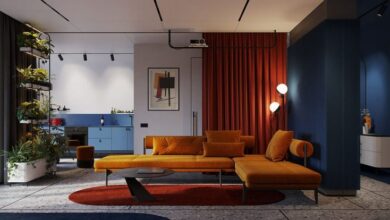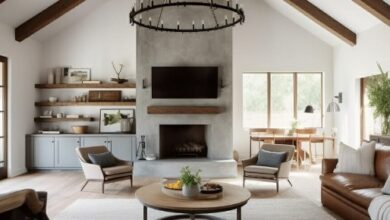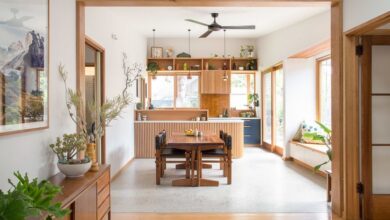Home Interior Design
Creating a beautifully designed home interior can seem like a daunting task, but with the right guidance and inspiration, it can be an enjoyable and rewarding process. Whether you’re starting from scratch or looking to refresh your current decor, this guide covers essential aspects of home interior design to help you create a space that reflects your personality and meets your lifestyle needs.
1. Understanding Your Style
Before diving into the details, it’s important to identify your personal style. This will serve as a foundation for your design decisions. Here are some popular styles to consider:
1. Modern:
- Characteristics: Clean lines, minimalistic, neutral color palette, open spaces.
- Key Elements: Sleek furniture, metal accents, glass, and concrete.
2. Traditional:
- Characteristics: Classic, elegant, detailed woodwork, rich colors.
- Key Elements: Ornate furniture, antique pieces, heavy drapery, and symmetry.
3. Rustic:
- Characteristics: Cozy, natural materials, earthy tones.
- Key Elements: Exposed beams, stone accents, wooden furniture, and handmade decor.
4. Contemporary:
- Characteristics: Current, evolving, mix of old and new.
- Key Elements: Bold colors, unique shapes, and eclectic mix of furniture.
5. Scandinavian:
- Characteristics: Simple, functional, light colors, and natural materials.
- Key Elements: Light wood, clean lines, and minimalistic decor.
2. Planning Your Space
Effective space planning is crucial in interior design. Consider the following steps:
1. Assess the Space:
- Measure the dimensions of each room.
- Note architectural features like windows, doors, and built-in elements.
2. Functionality:
- Determine the purpose of each room.
- Consider how the space will be used and by whom.
3. Flow:
- Plan for smooth movement between rooms.
- Ensure furniture placement does not obstruct pathways.
3. Choosing a Color Scheme
Color plays a significant role in setting the mood of a space. Here’s how to choose the right color scheme:
1. Start with a Base Color:
- Choose a neutral base color for walls and large pieces of furniture.
- Common base colors include white, beige, gray, and soft pastels.
2. Add Accent Colors:
- Incorporate accent colors through decor, cushions, rugs, and smaller pieces of furniture.
- Use a color wheel to find complementary or contrasting colors.
3. Consider the Room’s Purpose:
- Use calming colors like blues and greens in bedrooms and bathrooms.
- Choose vibrant colors like reds and yellows for living areas and kitchens.
4. Selecting Furniture
Furniture selection is essential to creating a cohesive and functional space. Keep these tips in mind:
1. Scale and Proportion:
- Choose furniture that fits the scale of the room.
- Avoid oversized pieces in small spaces and vice versa.
2. Quality over Quantity:
- Invest in high-quality, timeless pieces that will last.
- Mix and match with affordable, trendy items to keep the look fresh.
3. Comfort and Functionality:
- Ensure that furniture is comfortable and meets your needs.
- Consider multi-functional pieces like sofa beds and extendable tables.
5. Lighting Design
Lighting can transform the ambiance of your home. Consider layering different types of lighting:
1. Ambient Lighting:
- Provides overall illumination.
- Use ceiling fixtures, chandeliers, and recessed lights.
2. Task Lighting:
- Focuses on specific areas where tasks are performed.
- Use desk lamps, under-cabinet lights, and reading lights.
3. Accent Lighting:
- Highlights architectural features and decor.
- Use spotlights, wall sconces, and LED strips.
6. Adding Textures and Patterns
Textures and patterns add depth and interest to your design. Here’s how to incorporate them effectively:
1. Mix Textures:
- Combine different materials like wood, metal, glass, and fabrics.
- Use rugs, cushions, throws, and curtains to add tactile elements.
2. Balance Patterns:
- Use patterns in moderation to avoid overwhelming the space.
- Mix large-scale patterns with smaller, more subtle ones.
3. Layering:
- Layer textures and patterns to create a cozy, inviting atmosphere.
- Use rugs on hardwood floors, cushions on sofas, and throws on beds.
7. Personalizing Your Space
Your home should reflect your personality and style. Here’s how to add personal touches:
1. Artwork:
- Display artwork that you love and that resonates with you.
- Create a gallery wall or use large statement pieces.
2. Photos and Memorabilia:
- Showcase family photos and travel souvenirs.
- Use stylish frames and display them on shelves or walls.
3. DIY Projects:
- Incorporate handmade items like knitted throws, painted vases, or custom furniture.
- Personal projects add a unique and meaningful touch to your home.
8. Incorporating Greenery
Plants can enhance the aesthetic and improve the air quality of your home. Consider the following:
1. Indoor Plants:
- Choose low-maintenance plants like succulents, snake plants, or pothos.
- Use decorative pots and planters to add to the decor.
2. Vertical Gardens:
- Create a living wall with vertical planters.
- Ideal for small spaces or as a statement piece.
3. Fresh Flowers:
- Use fresh flowers to add color and fragrance.
- Change arrangements regularly to keep the look fresh.
9. Optimizing Storage
Effective storage solutions keep your home organized and clutter-free. Here are some ideas:
1. Built-In Storage:
- Use built-in shelves and cabinets to maximize space.
- Custom solutions can be designed to fit your specific needs.
2. Multi-Functional Furniture:
- Choose furniture with built-in storage, like ottomans, beds with drawers, and coffee tables with storage.
- Saves space and keeps items out of sight.
3. Decorative Storage:
- Use decorative baskets, boxes, and bins to organize items.
- Keep frequently used items accessible but neatly stored.
10. Budget-Friendly Tips
You don’t need a big budget to create a beautiful home. Here are some cost-effective tips:
1. DIY Decor:
- Create your own decor items, like painted vases, framed artwork, or knitted throws.
- Adds a personal touch without breaking the bank.
2. Thrift and Upcycle:
- Shop at thrift stores, flea markets, and garage sales for unique finds.
- Upcycle old furniture with a fresh coat of paint or new hardware.
3. Focus on Key Pieces:
- Invest in a few key pieces that make a big impact, like a statement sofa or an elegant dining table.
- Use affordable accessories to complement these pieces.
Conclusion
Designing your home interior can be a fulfilling and creative process. By understanding your style, planning your space, and carefully selecting furniture, colors, and decor, you can create a home that is both beautiful and functional. Remember to personalize your space with items that reflect your personality and to incorporate practical storage solutions to keep your home organized. With these tips, you’re well on your way to creating a stunning and inviting home interior.




